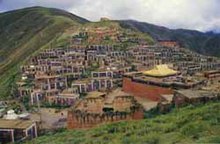Gyêgu

Gyêgu , also Jyekundo ( Tibetan སྐྱེ་ དགུ་ མདོ་ , transcription after Wylie skye dgu mdo , also Kyegu Do , Chinese 结 古镇 , Pinyin Jiēgǔ Zhèn ; earlier transcriptions: Kegudo, Kegedo, Kierkoudo, Kyegundo, Yekoundo, Dschje-kundo, Gyegundo, Gyegundo , Gyäkundo ), a large village in the Autonomous County Yushu of Tibetans in the Chinese province of Qinghai . It is the cultural, political and administrative center, the "capital" of the autonomous district. Located in the north of the traditional Tibetan cultural province of Kham , Gyêgu was, as a relatively small trading place, one of the two most important trading hubs on the way to Tibet .
As the main town of Yushu, the large community is now mostly also called "Yushu". It is also the seat of the government of Yushu City . Gyêgu has an area of 807.7 km² and a resident population, the number of which is between 40,000 and 60,000. About 85% of it is Tibetan. With an altitude of 3,700-3,800 m, it is slightly higher than Lhasa .
history
The history of the old trading place Jyekundo goes back very far and is closely intertwined with the monasteries in the area, especially the Sakya monastery Döndrub Ling , which is enthroned above the city and which was founded in 1398 on the site of a Bön monastery that already existed here. As part of the former kingdom of Nangchen , a second secular local power developed at the trading center under the local lama hierarch of Döndrub Ling, the Drawu Mergen, who resided in the monastery, and it extended over the wider area to the north of the Dri Chu (Jamgtse).
In the first half of the 20th century, there were fewer than 700 families in Jyekundo. For 1937 a population of 2,244 inhabitants (without monks and only temporarily present traders) is given, the built-up area is said to have been less than one square kilometer at that time.
The 9th Penchen Lama Thubten Chökyi Nyima , who had fled from central Tibetan Samzhubzê in 1924 to Inner Mongolia and then to Qinghai / Amdo for domestic political reasons, stayed in Gyêgu from 1936 in the hope of returning to Xigazê (Shigatse) soon where he died on December 1, 1937.
earthquake
On April 14, 2010, at 7:49 a.m. local time, a violent earthquake with a magnitude 7.1, according to Richter , shook the region around Gyêgu.
The quake claimed numerous victims and left most of the city in ruins: approx. 80–90% of the buildings were destroyed, which particularly affected the simple mud buildings of the nomads in the outskirts. Their buildings were virtually razed to the ground by the quake.
reconstruction
At the end of April / May 2010 it was announced that the city would be rebuilt as an "Ecotourist City" within three years with funds from the central government.
To this end, the State Council provided a sum of over 10 billion yuan by the end of 2010 for the first reconstruction phase, which provides for accompanying supply measures with temporary housing. In total, around three times the amount is planned.
See also
swell
- A. Gruschke: The Cultural Monuments of Tibet's Outer Provinces: Kham vol. 2 - The Qinghai Part of Kham (Yushu Autonomous Prefecture) , Bangkok 2005
- Jörg Gertel, Andreas Gruschke and Ingo Breuer: Regionalization and Urbanization in Eastern Tibet, in: International Asia Forum , 40 (2009), No. 1-2, pp. 119-141.
Individual evidence
- ↑ Gertel et al. 2009
- ↑ Kurier : Hundreds of dead after the quake in Tibet ( Memento from April 17, 2010 in the Internet Archive )
- ↑ Yushu Earthquake Relief: Yushu Update Information as of April 16, 12:24 am local time 4/16 ( memento of the original from April 21, 2010 in the Internet Archive ) Info: The archive link was automatically inserted and not yet checked. Please check the original and archive link according to the instructions and then remove this notice. (accessed on April 16, 2010)
- ↑ China Fact Tours: The Post-Seismic Yushu - An Eco-Tourism City To Be ( Memento of the original from October 15, 2012 in the Internet Archive ) Info: The archive link was inserted automatically and has not yet been checked. Please check the original and archive link according to the instructions and then remove this notice. , April 26, 2010. - China Briefing: State Council Notice Supporting Post-Earthquake Reconstruction in Yushu , May 31, 2010
- ↑ China Daily : Yushu reconstruction to be finished in 3 yrs .
- ^ Chinese Government's Official Web Portal: China to start Yushu quake reconstruction
Web links
- Badische Zeitung: Earthquake in China: "Reconstruction will take years" , May 11, 2010.
- Yushu Earthquake Relief Updated earthquake information and relief efforts, website of Plateauperspectives, an international non-profit organization based in Xining and Yushu.
Coordinates: 33 ° 1 ′ 0 ″ N , 96 ° 44 ′ 0 ″ E


